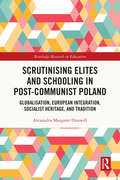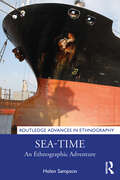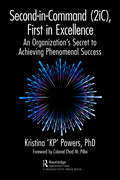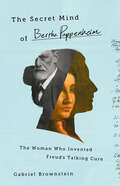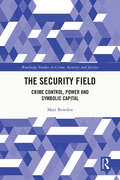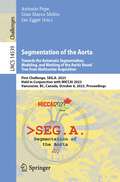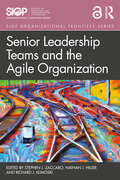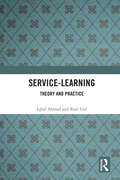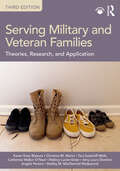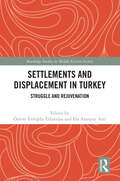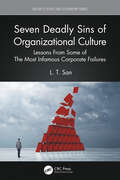- Table View
- List View
The Scottish State and European Migrants, 1885–1939: Managing Foreignness (Palgrave Studies in Migration History)
by Terence McBrideThis book examines the efforts of the government in Scotland to manage the increase of migrants travelling to Britain at the end of the nineteenth century. Focussing on the period between 1885 and 1939, the book explores how the Scottish machinery of government handled the administration of ‘foreigners.’ The author uses a comparative, thematic approach to analyse migrant experiences, identities, and relationships with state institutions. Drawing from state records held by the National Records of Scotland in Edinburgh, the book argues that Scottish officials in semi-autonomous boards began to recognise, describe and enumerate the presence of the ‘foreigner’ in the early twentieth century, framing their handling of foreignness in accordance with the Aliens Act of 1905. The author goes on to explain that institutions operating in Scotland developed a distinctly Scottish approach to alien matters, which continued up until the Second Word War. Therefore, an increasing number of importantdecisions affecting migrants were taken by a distinctly Scottish machinery of government, impacting on how Scottish officials understood foreignness, and how those identified as foreigners understood their identity in relation to Scottishness. Contributing significantly to current heated debates on migration and identity amongst researchers and the general public in Europe and beyond, this book provides essential insights into the ways in which a ‘sub-state’ began to develop practices, processes and attitudes towards migration which were not always in line with that of the central government.
Scrutinising Elites and Schooling in Post-Communist Poland: Globalisation, European Integration, Socialist Heritage, and Tradition (Routledge Research in Education)
by Alexandra Margaret DunwillThis book offers new insights and methodological tools to improve our understandings of how prestigious schools in Poland navigate the major political, social and cultural crosscurrents. The range of choice for elite schooling in Poland has expanded during its post-communist transformation. However, while elite education in countries such as the US, Australia, UK, France, and Switzerland has been extensively studied, post-communist countries have been largely neglected. This book explores the emergence of such schools within a context influenced by a range of different and often conflicting social forces. In doing so, the study elucidates how the socio-historical processes since 1989 diversified Poland’s egalitarian education system and facilitated the emergence of schools for elites. The book demonstrates that social and political changes in Poland triggered the emergence of new elites with different political and social outlooks, leading to a variety of types of elite schools that reflect and reproduce the elites’ positions and idiosyncrasies. A bespoke theoretical arrangement scrutinises extant and generated data from elite schools’ websites, online readers’ forums, and interviews with elite school principals. The book contributes new insights into elite schools in Central and Eastern European (CEE) countries, enriching the existing body of knowledge on elites and elite schools around the world. It will be of interest to researchers and postgraduate students investigating elite education, sociology of education, education policy, and education and international development.
Scrutinising Elites and Schooling in Post-Communist Poland: Globalisation, European Integration, Socialist Heritage, and Tradition (Routledge Research in Education)
by Alexandra Margaret DunwillThis book offers new insights and methodological tools to improve our understandings of how prestigious schools in Poland navigate the major political, social and cultural crosscurrents. The range of choice for elite schooling in Poland has expanded during its post-communist transformation. However, while elite education in countries such as the US, Australia, UK, France, and Switzerland has been extensively studied, post-communist countries have been largely neglected. This book explores the emergence of such schools within a context influenced by a range of different and often conflicting social forces. In doing so, the study elucidates how the socio-historical processes since 1989 diversified Poland’s egalitarian education system and facilitated the emergence of schools for elites. The book demonstrates that social and political changes in Poland triggered the emergence of new elites with different political and social outlooks, leading to a variety of types of elite schools that reflect and reproduce the elites’ positions and idiosyncrasies. A bespoke theoretical arrangement scrutinises extant and generated data from elite schools’ websites, online readers’ forums, and interviews with elite school principals. The book contributes new insights into elite schools in Central and Eastern European (CEE) countries, enriching the existing body of knowledge on elites and elite schools around the world. It will be of interest to researchers and postgraduate students investigating elite education, sociology of education, education policy, and education and international development.
Scrutinising Polarisation: Patterns and Consequences of Occupational Transformation in the Swedish Labour Market (Routledge Studies in the Sociology of Work, Professions and Organisations)
by Tomas Berglund Ylva Ulfsdotter ErikssonThis book scrutinises polarisation in Sweden, identifying patterns and variations in labour market transformation and exploring the consequences in terms of jobs, income, prestige, unionization and employment security, as well as the effects on different social groups. Through a series of empirical studies, it sheds light on changes in the occupational structure and the ways in which these changes interact with other societal trends, such as increased temporary employment, rising migration and decreased unionization, whilst also exploring changes in the evaluation of occupations and attitudes towards trade unions. Drawing on distinctly sociological perspectives, it shows how transformations in society and the labour market have affected conditions for individuals and considers whether these changes reinforce existing inequalities occasioned by polarisation or create new ones. Scrutinising Polarisation considers whether and how the Swedish labour market has polarized – and, if so, what this means for individual employees and labour organizations. It will therefore appeal to scholars with interests in the sociology of work and professions, social inequalities and labour market transformations.
Scrutinising Polarisation: Patterns and Consequences of Occupational Transformation in the Swedish Labour Market (Routledge Studies in the Sociology of Work, Professions and Organisations)
This book scrutinises polarisation in Sweden, identifying patterns and variations in labour market transformation and exploring the consequences in terms of jobs, income, prestige, unionization and employment security, as well as the effects on different social groups. Through a series of empirical studies, it sheds light on changes in the occupational structure and the ways in which these changes interact with other societal trends, such as increased temporary employment, rising migration and decreased unionization, whilst also exploring changes in the evaluation of occupations and attitudes towards trade unions. Drawing on distinctly sociological perspectives, it shows how transformations in society and the labour market have affected conditions for individuals and considers whether these changes reinforce existing inequalities occasioned by polarisation or create new ones. Scrutinising Polarisation considers whether and how the Swedish labour market has polarized – and, if so, what this means for individual employees and labour organizations. It will therefore appeal to scholars with interests in the sociology of work and professions, social inequalities and labour market transformations.
Sea-Time: An Ethnographic Adventure (ISSN)
by Helen SampsonThis book is an ethnography that draws upon 25 years of qualitative research and shipboard fieldwork in the merchant cargo shipping sector. It explores the lives and work of seafarers and how these have changed over time. Change over time and the experience of time on board are organising themes throughout the text. They are contextualised with accounts of transformation in the regulation of the shipping industry and technological innovation.The book begins with a unique account of a voyage on a container ship. In this, the author details both the research process and the daily activities and shared thoughts of the seafarers who are on board. The narrative is further enhanced with illustrative examples taken from other voyages to illustrate continuities and change over time.The book will be of value to individuals, scholars, and researchers interested in ethnography of all kinds. Sociologists, anthropologists, maritime studies students, seafarers, ship operators and policy makers will find the text engaging and revealing. It provides a vivid account that will appeal to academics interested in the study of work, workplace change and time. It is accessibly written and will be enjoyed by readers interested in the contemporary shipping industry, and the life and work of seafarers.
Sea-Time: An Ethnographic Adventure (ISSN)
by Helen SampsonThis book is an ethnography that draws upon 25 years of qualitative research and shipboard fieldwork in the merchant cargo shipping sector. It explores the lives and work of seafarers and how these have changed over time. Change over time and the experience of time on board are organising themes throughout the text. They are contextualised with accounts of transformation in the regulation of the shipping industry and technological innovation.The book begins with a unique account of a voyage on a container ship. In this, the author details both the research process and the daily activities and shared thoughts of the seafarers who are on board. The narrative is further enhanced with illustrative examples taken from other voyages to illustrate continuities and change over time.The book will be of value to individuals, scholars, and researchers interested in ethnography of all kinds. Sociologists, anthropologists, maritime studies students, seafarers, ship operators and policy makers will find the text engaging and revealing. It provides a vivid account that will appeal to academics interested in the study of work, workplace change and time. It is accessibly written and will be enjoyed by readers interested in the contemporary shipping industry, and the life and work of seafarers.
Second-in-Command (2iC), First in Excellence: An Organization's Secret to Achieving Phenomenal Success
by Kristina 'KP' Powers, PhDWhy do some departments, divisions, and organizations soar while others struggle? Watching another team achieve the success you feel yours more rightfully deserves can be incredibly frustrating. However, they might have something you don’t: Seconds-in-Command. Given how many Seconds-in-Command exist in the workforce, it is stunning that there are so few books about them. Organizations can and often do have more than one 2iC; large ones may have hundreds. KP Powers focuses on essential skills that individuals in these positions already possess and can enhance to become an organization’s key to achieving phenomenal success. This book introduces the groundbreaking concept of linking multiple 2iCs to form a Second-in-Command chain. This game-changing technique increases the positive impact that 2iCs can have on organizational and leader success. In today’s world, leaders no longer have the luxury of hiring more people to keep up with a growing workload. The labor shortage and the need to cut costs because of looming economic issues make that impractical. It makes more sense to consider a new organizational framework that includes 2iCs, thus multiplying existing team members’ contributions. This is especially critical in highly regulated fields such as higher education, finance, and health care, where the stakes and penalties are high and unforgiving. Second-in-Command, First in Excellence invites readers to think differently about this critical role. Geared toward leaders who have or want a 2iC as well as 2iCs themselves, this book both demonstrates the value of the 2iC position and serves as a tool for professional development.
Second-in-Command (2iC), First in Excellence: An Organization's Secret to Achieving Phenomenal Success
by Kristina 'KP' Powers, PhDWhy do some departments, divisions, and organizations soar while others struggle? Watching another team achieve the success you feel yours more rightfully deserves can be incredibly frustrating. However, they might have something you don’t: Seconds-in-Command. Given how many Seconds-in-Command exist in the workforce, it is stunning that there are so few books about them. Organizations can and often do have more than one 2iC; large ones may have hundreds. KP Powers focuses on essential skills that individuals in these positions already possess and can enhance to become an organization’s key to achieving phenomenal success. This book introduces the groundbreaking concept of linking multiple 2iCs to form a Second-in-Command chain. This game-changing technique increases the positive impact that 2iCs can have on organizational and leader success. In today’s world, leaders no longer have the luxury of hiring more people to keep up with a growing workload. The labor shortage and the need to cut costs because of looming economic issues make that impractical. It makes more sense to consider a new organizational framework that includes 2iCs, thus multiplying existing team members’ contributions. This is especially critical in highly regulated fields such as higher education, finance, and health care, where the stakes and penalties are high and unforgiving. Second-in-Command, First in Excellence invites readers to think differently about this critical role. Geared toward leaders who have or want a 2iC as well as 2iCs themselves, this book both demonstrates the value of the 2iC position and serves as a tool for professional development.
The Secret Mind of Bertha Pappenheim: The Woman Who Invented Freud's Talking Cure
by Gabriel BrownsteinThe story of a patient who changed the world, and the mystery of her illness. In 1880, young Bertha Pappenheim got strangely ill—she lost her ability to control her voice and her body. She was treated by Sigmund Freud&’s mentor, Josef Breuer, who diagnosed her with &“hysteria.&” Together, Pappenheim and Breuer developed what she called &“the talking cure&”—talking out memories to eliminate symptoms. Freud renamed her &“Anna O&” and appropriated her ideas to form the theory of psychoanalysis. All his life, he told lies about her. For over a century, writers have argued about her illness and cure. In this unusual work of science, history, and psychology, Brownstein does more than describe the controversies surrounding this extraordinary woman. He brings Pappenheim to life—a brilliant feminist thinker, a crusader against human trafficking, and a pioneer—in the hustling and heady world of nineteenth-century Vienna. At the same time, he tells a parallel story that is playing out in leading medical centers today, about patients who suffer symptoms very much like Pappenheim&’s, and about the doctors who are trying to cure them—the story of the neuroscience of a condition now called FND.The Secret Mind of Bertha Pappenheim argues for the healing art of listening and describes the new &“talking cures&” emerging out of neuroscience today.
The Security Field: Crime Control, Power and Symbolic Capital (Routledge Studies in Crime, Security and Justice)
by Matt BowdenHow crime and security are governed has become a critical issue in criminology over the first quarter of the twenty-first century. Today, we see a broader landscape of regulatory players who are involved in the control and management of crime, whether in crime prevention, safety in the community or in providing private security services. The Security Field: Crime Control, Power and Symbolic Capital gets to grips with these changes and argues that this forms an emerging field in which different players appear to compete and co-operate but are ultimately vying to shape and order the field. This book draws on new thinking in the social sciences on questions of crime, fear and security and contributes to the expanding interest on the sociology and criminology of security by offering a Bourdieusian approach to plural policing and the everyday political economy of security.Drawing from Bourdieu’s concept of field, this book builds a theory of the security field based upon a series of in-depth interviews with security actors such as senior police officers, NGOs, private security professionals, government officials and community safety workers in Ireland. It demonstrates how security producers compete for cultural capital in its many forms – as data, information and relationships – and ultimately as a way of cementing their positions in this emerging field. It shows the dominant power of the formal police and central government in shaping and ordering this relational space. In doing so, The Security Field: Crime Control, Power and Symbolic Capital builds an empirical case from three distinct areas of security production: urban security, community safety and the connections between regulated private security and public crime prevention. It explores the challenges of securitisation in respect of public safety, security and rights and the way in which social problems such as drug use, homelessness and urban marginality are recast as ‘security’ concerns.An accessible and compelling read, this book will appeal to students and scholars of criminology, sociology, urban studies and security studies.
The Security Field: Crime Control, Power and Symbolic Capital (Routledge Studies in Crime, Security and Justice)
by Matt BowdenHow crime and security are governed has become a critical issue in criminology over the first quarter of the twenty-first century. Today, we see a broader landscape of regulatory players who are involved in the control and management of crime, whether in crime prevention, safety in the community or in providing private security services. The Security Field: Crime Control, Power and Symbolic Capital gets to grips with these changes and argues that this forms an emerging field in which different players appear to compete and co-operate but are ultimately vying to shape and order the field. This book draws on new thinking in the social sciences on questions of crime, fear and security and contributes to the expanding interest on the sociology and criminology of security by offering a Bourdieusian approach to plural policing and the everyday political economy of security.Drawing from Bourdieu’s concept of field, this book builds a theory of the security field based upon a series of in-depth interviews with security actors such as senior police officers, NGOs, private security professionals, government officials and community safety workers in Ireland. It demonstrates how security producers compete for cultural capital in its many forms – as data, information and relationships – and ultimately as a way of cementing their positions in this emerging field. It shows the dominant power of the formal police and central government in shaping and ordering this relational space. In doing so, The Security Field: Crime Control, Power and Symbolic Capital builds an empirical case from three distinct areas of security production: urban security, community safety and the connections between regulated private security and public crime prevention. It explores the challenges of securitisation in respect of public safety, security and rights and the way in which social problems such as drug use, homelessness and urban marginality are recast as ‘security’ concerns.An accessible and compelling read, this book will appeal to students and scholars of criminology, sociology, urban studies and security studies.
Segmentation of the Aorta. Towards the Automatic Segmentation, Modeling, and Meshing of the Aortic Vessel Tree from Multicenter Acquisition: First Challenge, SEG.A. 2023, Held in Conjunction with MICCAI 2023, Vancouver, BC, Canada, October 8, 2023, Proceedings (Lecture Notes in Computer Science #14539)
by Antonio Pepe Gian Marco Melito Jan EggerThis book constitutes the First Segmentation of the Aorta Challenge, SEG.A. 2023, which was held in conjunction with the 26th International Conference on Medical Image Computing and Computer-Assisted Intervention, MICCAI 2023, on October 8, 2023. The 8 full and 3 short papers presented have been carefully reviewed and selected for inclusion in the book. They focus specifically on robustness, visual quality and meshing of automatically generated segmentations of aortic vessel trees from CT imaging. The challenge was organized as a ”container submission” challenge, where participants had to upload their algorithms to Grand Challenge in the form of Docker containers. Three tasks were created for SEG.A. 2023.
Segregierte Quartiere – segregierte Freizeiträume: Eine Studie zu Freizeitverhalten und Aktivitätsräumen Berliner Jugendlicher (Stadt, Raum und Gesellschaft)
by Moritz MertenDieses Open-Access-Buch stellt vor dem Hintergrund einer zunehmenden sozialen Segregation in deutschen Städten die Frage nach den Auswirkungen dieser sich verschärfenden räumlichen Polarisierung auf die Sozialisation von Jugendlichen. Die Arbeit geht dabei über den quartiersfixierten Ansatz der Nachbarschaftseffektforschung hinaus und untersucht, welche Räume in der Stadt von Berliner Jugendlichen in ihrer Freizeit tatsächlich genutzt werden und damit für sie sozialisationsrelevant sind. Der Fokus liegt auf dem Einfluss, den einerseits individuelle Merkmale, wie Geschlecht und sozialer Status, und andererseits die Stadtstruktur auf das räumliche Freizeitverhalten der Jugendlichen haben. Zentral ist dabei die Frage, ob sich die soziale Segregation der Wohnquartier auch in den Aktivitätsräumen der Jugendlichen widerspiegelt. Um diese Frage zu beantworten, werden Daten mit einer eigens für diese Arbeit entwickelten innovativen räumlich-quantitativen Befragung erhoben, vor dem Hintergrund der physischen und sozialräumlichen Struktur Berlins ausgewertet und durch qualitative Leitfadeninterviews ergänzt.
Senior Leadership Teams and the Agile Organization (SIOP Organizational Frontiers Series)
Senior Leadership Teams and the Agile Organization builds on existing knowledge in the leadership, teams, and strategic management literatures to examine and explore how senior leadership teams drive the dynamic capabilities of organizations. Organizational agility is a key dimension of organizational performance. This volume focuses on senior leadership team processes and attributes that facilitate organizational agility and the organization’s capacity to perform and rapidly pivot in response to shifting strategic demands. Chapters summarize the current state of knowledge, examine past research and theory, define research and theoretical gaps, and consider how to address these gaps. In so doing, they offer an understanding of how senior leadership teams drive and enable organizational activity. The book is essential reading for researchers and professionals looking to understand the intersection of leadership, team dynamics, organizational psychology, organizational psychology, and strategic management, particularly in relation to organizational agility and the senior leadership team.
Senior Leadership Teams and the Agile Organization (SIOP Organizational Frontiers Series)
by Stephen J. Zaccaro Nathan J. Hiller Richard J. KlimoskiSenior Leadership Teams and the Agile Organization builds on existing knowledge in the leadership, teams, and strategic management literatures to examine and explore how senior leadership teams drive the dynamic capabilities of organizations. Organizational agility is a key dimension of organizational performance. This volume focuses on senior leadership team processes and attributes that facilitate organizational agility and the organization’s capacity to perform and rapidly pivot in response to shifting strategic demands. Chapters summarize the current state of knowledge, examine past research and theory, define research and theoretical gaps, and consider how to address these gaps. In so doing, they offer an understanding of how senior leadership teams drive and enable organizational activity. The book is essential reading for researchers and professionals looking to understand the intersection of leadership, team dynamics, organizational psychology, organizational psychology, and strategic management, particularly in relation to organizational agility and the senior leadership team.
Service-Learning: Theory and Practice
by Iqbal Ahmad Rani GulThis book examines key concepts, principles, and applications of the service-learning approach. Service-learning is a community-based educational approach to improve a student’s academic, personal, leadership, civic, and professional development through civic engagement. Unlike other traditional approaches to education, service-learning students can use their classroom-based knowledge and skills in a real-life context in collaboration with community organisations and residents. This volume explores the theory, research, and practices of how service-learning is understood, implemented, and evaluated in different contexts. It provides essential guidelines to implement and integrate service-learning at educational institutions through extensive discussions on the principles, philosophical challenges, opportunities, and its applications. Key themes include: • Theory of service-learning • Concept of service-learning • Challenges to service-learning • Applications of service-learning • Service-learning as professional development • Service-learning as communication Accessibly written, this book would be of interest to faculty, students, community organisations, and researchers working in the areas of education, pedagogy, sociology, and social work.
Service-Learning: Theory and Practice
by Iqbal Ahmad Rani GulThis book examines key concepts, principles, and applications of the service-learning approach. Service-learning is a community-based educational approach to improve a student’s academic, personal, leadership, civic, and professional development through civic engagement. Unlike other traditional approaches to education, service-learning students can use their classroom-based knowledge and skills in a real-life context in collaboration with community organisations and residents. This volume explores the theory, research, and practices of how service-learning is understood, implemented, and evaluated in different contexts. It provides essential guidelines to implement and integrate service-learning at educational institutions through extensive discussions on the principles, philosophical challenges, opportunities, and its applications. Key themes include: • Theory of service-learning • Concept of service-learning • Challenges to service-learning • Applications of service-learning • Service-learning as professional development • Service-learning as communication Accessibly written, this book would be of interest to faculty, students, community organisations, and researchers working in the areas of education, pedagogy, sociology, and social work.
Serving Military and Veteran Families: Theories, Research, and Application
by Karen Rose Blaisure Christina M. Marini Tara Saathoff-Wells Catherine Walker O’Neal Mallory Lucier-Greer Amy Laura Dombro Colonel Angela Pereira Shelley M. MacDermid WadsworthServing Military and Veteran Families introduces readers to the unique culture of military families, their resilience, and the challenges of military life. It reviews the latest research, theories, policies, and programs to prepare readers for understanding and working with military and veteran families. It also offers practical knowledge about the challenges that come with military family life and the federal policies, laws, and programs that support military and veteran families. Boasting a new full-color design and rich with pedagogy, the text also includes several boxed elements in each chapter. "Spotlight on Research" highlights researchers who study military and veteran families with the goal of informing and enriching the work of family support professionals. "Voices from the Frontline" presents the real-life stories of support program leaders, practitioners, researchers, policymakers, and most importantly service members and veterans and their families. "Tips from the Frontline" offers concrete, hands-on suggestions based on the experiences and wisdom of the people featured in the text and the broader research and practice communities. Third Edition features: Streamlined focus on theories and the addition of the contextual model of family stress and life course theory, including an interview with Glen Elder in which he shares his perspective on the development of life course theory and how it can be applied to understand development across individuals and cohorts. Personal accounts of 70 program leaders, practitioners, researchers, policymakers, and, significantly, service members, veterans, and family members who offer insight into their personal experiences, successes, and challenges associated with military life. 20 new interviews with service members, veterans, family members, researchers, and clinicians that bring important topics to life. Updated demographics and descriptions of service members, veterans, and their families. Expanded descriptions of mental health treatment approaches with an emphasis on including family members. Updated exercises focused on providing services to military and veteran families. New online resources designed to further enrich discourse and discussion. Serving Military and Veteran Families is designed as a core text for advanced undergraduate or graduate courses on military and veteran families, or as a supplement for related courses taught in family science, human development, family life education, social work, and clinical or counseling psychology programs. Providing a foundation for working with increased sensitivity, knowledge, and respect, the text can also be a useful resource for helping professionals who work with military and veteran families.
Serving Military and Veteran Families: Theories, Research, and Application
by Karen Rose Blaisure Christina M. Marini Tara Saathoff-Wells Catherine Walker O’Neal Mallory Lucier-Greer Amy Laura Dombro Colonel Angela Pereira Shelley M. MacDermid WadsworthServing Military and Veteran Families introduces readers to the unique culture of military families, their resilience, and the challenges of military life. It reviews the latest research, theories, policies, and programs to prepare readers for understanding and working with military and veteran families. It also offers practical knowledge about the challenges that come with military family life and the federal policies, laws, and programs that support military and veteran families. Boasting a new full-color design and rich with pedagogy, the text also includes several boxed elements in each chapter. "Spotlight on Research" highlights researchers who study military and veteran families with the goal of informing and enriching the work of family support professionals. "Voices from the Frontline" presents the real-life stories of support program leaders, practitioners, researchers, policymakers, and most importantly service members and veterans and their families. "Tips from the Frontline" offers concrete, hands-on suggestions based on the experiences and wisdom of the people featured in the text and the broader research and practice communities. Third Edition features: Streamlined focus on theories and the addition of the contextual model of family stress and life course theory, including an interview with Glen Elder in which he shares his perspective on the development of life course theory and how it can be applied to understand development across individuals and cohorts. Personal accounts of 70 program leaders, practitioners, researchers, policymakers, and, significantly, service members, veterans, and family members who offer insight into their personal experiences, successes, and challenges associated with military life. 20 new interviews with service members, veterans, family members, researchers, and clinicians that bring important topics to life. Updated demographics and descriptions of service members, veterans, and their families. Expanded descriptions of mental health treatment approaches with an emphasis on including family members. Updated exercises focused on providing services to military and veteran families. New online resources designed to further enrich discourse and discussion. Serving Military and Veteran Families is designed as a core text for advanced undergraduate or graduate courses on military and veteran families, or as a supplement for related courses taught in family science, human development, family life education, social work, and clinical or counseling psychology programs. Providing a foundation for working with increased sensitivity, knowledge, and respect, the text can also be a useful resource for helping professionals who work with military and veteran families.
Settlements and Displacement in Turkey: Struggle and Rejuvenation (Routledge Studies in Middle Eastern Society)
by Özlem Erdoğdu Erkarslan Ela Alanyalı AralThis book explores the complex relationship between urban space and displacement in Turkey. It evaluates how the displacement of people and cultures has affected the spatiotemporal landscapes of the nation at different periods of contemporary Turkey, with an emphasis on various narratives of the relocating population and their relationship to the environment. Contemporary cities are constantly changing due to the movement of people from different regions, resulting in shifting population patterns globally. Understanding displacement and its effects on space are crucial in studying this phenomenon, as it not only involves the physical relocation of individuals, but also the transfer of cultural practices within a condensed timeframe. This process changes the destination of settlements irreversibly. This book takes a methodological approach and disclinary approach, examining the migration and displacement of people and its effects upon art, architecture, culture and politics in Turkish cities. This book will be of interest to students and scholars interested in migration and its effects on cities, urban planning and architecture.
Settlements and Displacement in Turkey: Struggle and Rejuvenation (Routledge Studies in Middle Eastern Society)
by Özlem Erdo 287 Du Erkarslan Ela Alanyal 305 AralThis book explores the complex relationship between urban space and displacement in Turkey. It evaluates how the displacement of people and cultures has affected the spatiotemporal landscapes of the nation at different periods of contemporary Turkey, with an emphasis on various narratives of the relocating population and their relationship to the environment. Contemporary cities are constantly changing due to the movement of people from different regions, resulting in shifting population patterns globally. Understanding displacement and its effects on space are crucial in studying this phenomenon, as it not only involves the physical relocation of individuals, but also the transfer of cultural practices within a condensed timeframe. This process changes the destination of settlements irreversibly. This book takes a methodological approach and disclinary approach, examining the migration and displacement of people and its effects upon art, architecture, culture and politics in Turkish cities. This book will be of interest to students and scholars interested in migration and its effects on cities, urban planning and architecture.
Seven Bad Habits of Safety Management: Examining Systemic Failure (Innovation and Creativity in Health and Safety)
by Murray RitchieOccupational Health and Safety has been a growth industry for several decades and has moved beyond the realm of the human resource department and workers’ compensation claims. However, the methodologies utilized and taught within the profession have changed little since the 1930s. The industry continues to operate in a "comfort zone" and, as such, has reached an improvement plateau. This important book examines seven of these antiquated comfort zones from their conceptions to implementation and explores why they fail to achieve the desired results and what alternatives are available. Seven Bad Habits of Safety Management: Examining Systemic Failure delivers seven focused chapters outlining the comfort zones they create and their impacts on new initiatives. Each critically analyses common safety practices exploring where they came from, why they fail, and a few alternatives being discussed around the world. Case studies underpin learning that will allow the reader to revisit and revise their current programs and campaigns to realise a better return on their safety investment. The book will allow the reader to better understand the root causes of systems failures faced daily in the management of health and safety and how to confront them. This readable and exciting text from an author with over 40 years of experience in occupational health and safety will appeal to students, researchers and professionals of process safety, occupational safety, safety engineering, human resources and business management.
Seven Bad Habits of Safety Management: Examining Systemic Failure (Innovation and Creativity in Health and Safety)
by Murray RitchieOccupational Health and Safety has been a growth industry for several decades and has moved beyond the realm of the human resource department and workers’ compensation claims. However, the methodologies utilized and taught within the profession have changed little since the 1930s. The industry continues to operate in a "comfort zone" and, as such, has reached an improvement plateau. This important book examines seven of these antiquated comfort zones from their conceptions to implementation and explores why they fail to achieve the desired results and what alternatives are available. Seven Bad Habits of Safety Management: Examining Systemic Failure delivers seven focused chapters outlining the comfort zones they create and their impacts on new initiatives. Each critically analyses common safety practices exploring where they came from, why they fail, and a few alternatives being discussed around the world. Case studies underpin learning that will allow the reader to revisit and revise their current programs and campaigns to realise a better return on their safety investment. The book will allow the reader to better understand the root causes of systems failures faced daily in the management of health and safety and how to confront them. This readable and exciting text from an author with over 40 years of experience in occupational health and safety will appeal to students, researchers and professionals of process safety, occupational safety, safety engineering, human resources and business management.
Seven Deadly Sins of Organizational Culture: Lessons From Some of The Most Infamous Corporate Failures (Security, Audit and Leadership Series)
by L. T. SanThis book is about the primary symptoms present in a dysfunctional culture that could have devastating outcomes for any organization. The book outlines each of the seven sins in each chapter. Each of the first seven chapters (Chapters 1–7) starts with a famous quote related to each of the sins and then immediately recounts stories ripped from the headlines describing well-known corporate failures but with a personal touch from former employees who experienced those stories from inside the company. (The sources for these stories are all cited in their Bibliographies.) The seven sins of organizational culture are linked with seven different corporate scandals that serve as a "lesson learned" as well as seven stories of organizations that have been successful with each respective organizational attribute as follows: Flawed Mission and Misaligned Values uses WorldCom as the lesson learned and Patagonia as the success case. Flawed Incentives uses Wells Fargo as the lesson learned and Bridgeport Financial as the success case. Lack of Accountability uses HSBC as the lesson learned and McDonald’s as the success case. Ineffective Talent Management uses Enron as the lesson learned and Southwest Airlines as the success case. Lack of Transparency uses Theranos as the lesson learned and Zappos as the success case. Ineffective Risk Management uses the 2008 mortgage industry collapse as the lesson learned and Michael Burry as the success case. Ineffective Leadership summarizes all of the foregoing sins as failures of Leadership. In each chapter and for each organizational sin, the author offers seven attributes of a healthy culture to counter the cultural dysfunction. The seven healthy attributes for each of the seven sins are all original content. In Chapter 8, the author offers an approach for assessing an organization’s culture by providing seven ways to measure the different drivers of organizational culture. The ideas for how to measure corporate culture is original content, with some references to existing frameworks (all cited in the Bibliography.) Finally, in Chapter 9, the author offers a step-by-step outline for transforming the culture. The chapter starts with a story about how Korean Air suffered multiple crashes due to their corporate culture but were able to successfully transform their culture. (The source for the Korean Air story is cited in the Bibliography.) There are seven appendices, most of which are by the author except for the maturity of risk management, which references an OECD (government entity) risk management maturity framework.

